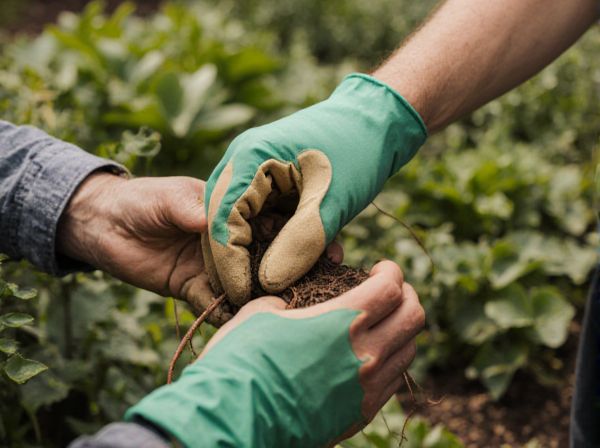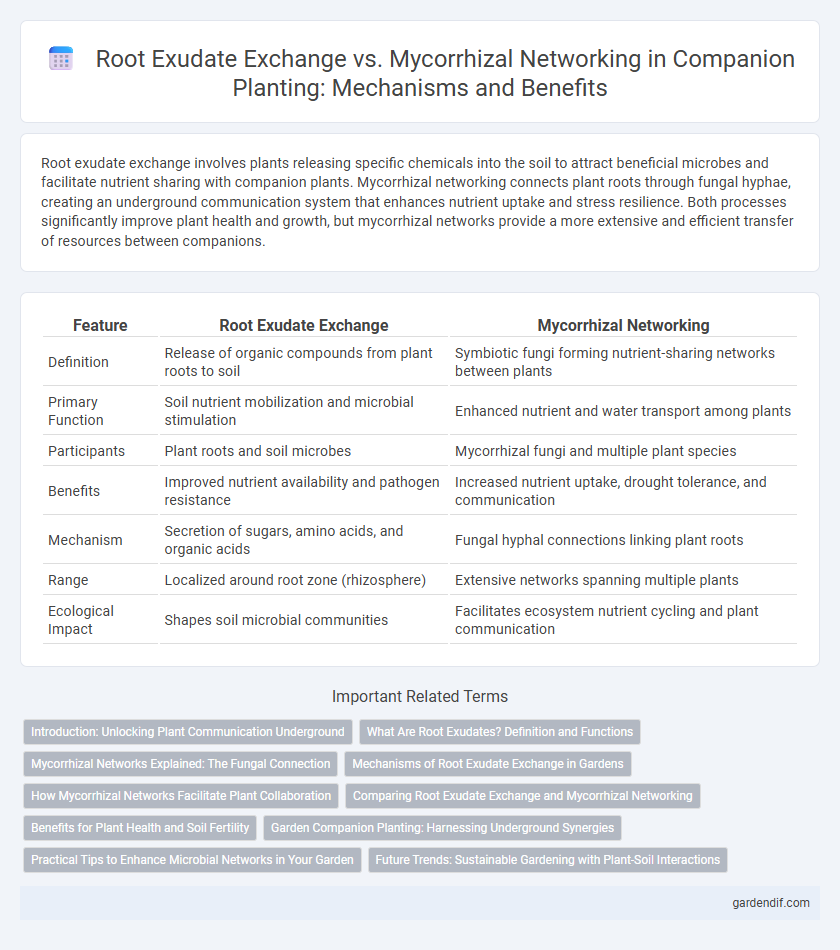
Root exudate exchange vs mycorrhizal networking Illustration
Root exudate exchange involves plants releasing specific chemicals into the soil to attract beneficial microbes and facilitate nutrient sharing with companion plants. Mycorrhizal networking connects plant roots through fungal hyphae, creating an underground communication system that enhances nutrient uptake and stress resilience. Both processes significantly improve plant health and growth, but mycorrhizal networks provide a more extensive and efficient transfer of resources between companions.
Table of Comparison
| Feature | Root Exudate Exchange | Mycorrhizal Networking |
|---|---|---|
| Definition | Release of organic compounds from plant roots to soil | Symbiotic fungi forming nutrient-sharing networks between plants |
| Primary Function | Soil nutrient mobilization and microbial stimulation | Enhanced nutrient and water transport among plants |
| Participants | Plant roots and soil microbes | Mycorrhizal fungi and multiple plant species |
| Benefits | Improved nutrient availability and pathogen resistance | Increased nutrient uptake, drought tolerance, and communication |
| Mechanism | Secretion of sugars, amino acids, and organic acids | Fungal hyphal connections linking plant roots |
| Range | Localized around root zone (rhizosphere) | Extensive networks spanning multiple plants |
| Ecological Impact | Shapes soil microbial communities | Facilitates ecosystem nutrient cycling and plant communication |
Introduction: Unlocking Plant Communication Underground
Root exudate exchange enables plants to release specific chemical signals and nutrients into the soil, facilitating direct interactions with microbes and neighboring plants to enhance growth and stress resilience. Mycorrhizal networking involves a symbiotic association where fungal hyphae connect multiple plant roots, creating an underground communication system for nutrient sharing and information transfer. These mechanisms collectively unlock complex plant communication, optimizing resource distribution and ecosystem stability beneath the soil surface.
What Are Root Exudates? Definition and Functions
Root exudates are organic compounds secreted by plant roots, including sugars, amino acids, and secondary metabolites, that facilitate nutrient mobilization and microbial interactions in the rhizosphere. These exudates play a crucial role in attracting beneficial soil microorganisms, enhancing nutrient uptake, and establishing symbiotic relationships such as mycorrhizal networks. Through root exudate exchange, plants can communicate with fungi and bacteria, optimizing resource distribution and improving overall plant health and soil fertility.
Mycorrhizal Networks Explained: The Fungal Connection
Mycorrhizal networks form intricate underground fungal connections linking plant roots, facilitating the exchange of nutrients, water, and signaling molecules across different species. Unlike root exudate exchange, which involves the direct release of organic compounds into the soil, mycorrhizal networks provide an extended hyphal system that enhances nutrient uptake, especially phosphorus and nitrogen. These fungal connections play a crucial role in plant health, stress resistance, and ecosystem stability by enabling interplant communication and resource sharing.
Mechanisms of Root Exudate Exchange in Gardens
Root exudate exchange in gardens facilitates the transfer of organic compounds like sugars, amino acids, and secondary metabolites secreted by plant roots into the rhizosphere, promoting microbial activity and nutrient availability. This process supports beneficial bacteria and fungi, enhancing soil fertility and plant health through nutrient solubilization and pathogen suppression. Unlike mycorrhizal networking, which links plants via fungal hyphae for nutrient sharing, root exudate exchange primarily relies on chemical signaling and resource allocation within the immediate root zone.
How Mycorrhizal Networks Facilitate Plant Collaboration
Mycorrhizal networks enable plants to exchange nutrients, water, and signaling molecules through interconnected fungal hyphae, enhancing collective growth and resilience. These underground webs facilitate carbon transfer and nutrient sharing, supporting weaker or younger plants by connecting them to established root systems. Root exudate exchange complements this process by releasing chemical signals and organic compounds that attract beneficial fungi, strengthening the symbiotic relationship within the mycorrhizal network.
Comparing Root Exudate Exchange and Mycorrhizal Networking
Root exudate exchange involves the direct release of organic compounds by plant roots to facilitate microbial interactions and nutrient uptake within the rhizosphere, enhancing soil health and plant growth. Mycorrhizal networking, in contrast, establishes symbiotic fungal connections between plant roots, enabling efficient nutrient and water transfer across multiple plants, improving ecosystem resilience. While root exudates primarily stimulate localized microbial activity, mycorrhizal networks create extensive underground communication channels linking diverse plant species.
Benefits for Plant Health and Soil Fertility
Root exudate exchange enriches the rhizosphere by releasing organic compounds that stimulate beneficial microbial communities, enhancing nutrient availability and promoting plant growth. Mycorrhizal networking connects plants through fungal hyphae, facilitating efficient nutrient and water transfer, improving plant resilience against stress and disease. Together, these processes boost soil fertility by increasing microbial diversity and nutrient cycling, leading to healthier plants and sustainable ecosystems.
Garden Companion Planting: Harnessing Underground Synergies
Root exudate exchange in garden companion planting enhances nutrient availability and soil health by releasing organic compounds that stimulate beneficial microbes, while mycorrhizal networking connects plant roots through fungal hyphae, facilitating efficient nutrient and water transfer between plants. These underground synergies improve plant growth, resilience, and yield by creating a collaborative soil ecosystem. Harnessing these interactions supports sustainable gardening practices by naturally optimizing resource sharing and pest resistance.
Practical Tips to Enhance Microbial Networks in Your Garden
Enhance microbial networks in your garden by promoting root exudate exchanges through diversified planting and organic mulching to stimulate beneficial bacteria and fungi. Incorporate mycorrhizal inoculants or encourage native mycorrhizal fungi by minimizing soil disturbance and maintaining proper soil moisture levels. Optimize soil structure with compost amendments to support extensive mycorrhizal networking, improving nutrient uptake and plant resilience.
Future Trends: Sustainable Gardening with Plant-Soil Interactions
Future trends in sustainable gardening emphasize enhancing plant-soil interactions through optimized root exudate exchange and advanced mycorrhizal networking techniques. Innovations in bioinoculants and precision agriculture promote efficient nutrient cycling, improving soil health and plant resilience. These practices support ecosystem sustainability by fostering symbiotic relationships that reduce chemical inputs and boost crop productivity.
Root exudate exchange vs mycorrhizal networking Infographic

 gardendif.com
gardendif.com